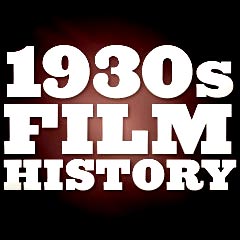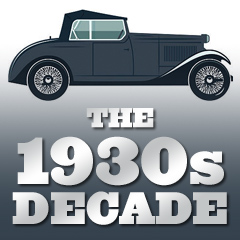|
The Golden Age of Hollywood: From 1930 to 1948
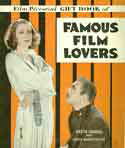 The
1930s decade (and most of the 1940s as well) has been nostalgically labeled
"The Golden Age of Hollywood" (although most of the output of the
decade was black-and-white). The 30s was also the decade of the sound
and color revolutions and the advance of the 'talkies', and the further
development of film genres (gangster films, musicals, newspaper-reporting
films, historical biopics, social-realism films, lighthearted screwball
comedies, westerns and horror to name a few). It was the era in which
the silent period ended, with many silent film stars not making the transition
to sound (e.g., Vilmy Banky, John Gilbert, and Norma Talmadge). By 1933,
the economic effects of the Depression were being strongly felt, especially
in decreased movie theatre attendance. The
1930s decade (and most of the 1940s as well) has been nostalgically labeled
"The Golden Age of Hollywood" (although most of the output of the
decade was black-and-white). The 30s was also the decade of the sound
and color revolutions and the advance of the 'talkies', and the further
development of film genres (gangster films, musicals, newspaper-reporting
films, historical biopics, social-realism films, lighthearted screwball
comedies, westerns and horror to name a few). It was the era in which
the silent period ended, with many silent film stars not making the transition
to sound (e.g., Vilmy Banky, John Gilbert, and Norma Talmadge). By 1933,
the economic effects of the Depression were being strongly felt, especially
in decreased movie theatre attendance.
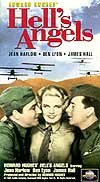 As the 1930s began, there were a number of unique firsts: As the 1930s began, there were a number of unique firsts:
- young 'platinum blonde' star Jean Harlow appeared
in her first major role in Howard Hughes' World War I aviation epic,
Hell's Angels (1930); the "Blonde
Bombshell" was signed by MGM in 1932 and soon became a major star
- enigmatic silent star Greta Garbo (originally named
Greta Lovisa Gustafsson), part of MGM's galaxy of stars and nicknamed
"The Divine Garbo" and "The Swedish sphinx," spoke her first
immortal, husky, Swedish-accented words in director Clarence Brown's
MGM film Anna Christie (1930). (As a
floozy, she spoke: "Gimme a vhiskey, ginger ale on the side. And don't
be stingy, baby") - it was Garbo's first talkie (advertised as "GARBO
TALKS!")
- the first of Hollywood's dramatic prison dramas
(a new subgenre) was produced by MGM, The Big House (1930), directed
by George Hill
- B-actor
John Wayne made his debut in his first major role in a western
directed by Raoul Walsh,
 The Big Trail (1930) - one of the first
films shot in Grandeur, Fox's experimental wide-screen 70mm format.
Both the film and the new process flopped; it would be nine more years
before his star-making appearance in Stagecoach
(1939) The Big Trail (1930) - one of the first
films shot in Grandeur, Fox's experimental wide-screen 70mm format.
Both the film and the new process flopped; it would be nine more years
before his star-making appearance in Stagecoach
(1939)
- Broadway actress Helen Hayes made her screen debut
in The Sin of Madelon Claudet (1931) and won the Best Actress
Academy Award for her first talkie
- MGM stars Clark Gable and Joan Crawford starred
together in the risque pre-Code film Dance, Fools, Dance (1931),
the first of eight features that teamed them together
- the best-known Charlie Chan actor, Warner Oland, played
the detective for the first time in Charlie Chan Carries On
(1931)
- RKO won its sole Best Picture Academy
Award for the western Cimarron (1931)
- in 1930, the Motion Picture Production Code,
administered by Joseph I. Breen (and former Postmaster General Will
Hays) set film guidelines regarding sex, violence, religion, and crime
(not yet strictly enforced until the Production Code Administration
(1934))
- the first daily newspaper for the film industry had
its debut in 1930, The Hollywood Reporter
- Katharine Hepburn made her screen debut in A Bill
of Divorcement (1932)
- Olympic swimming champion Johnny Weissmuller made his
screen debut as the vine-swinging ape-man in Tarzan,
the Ape Man (1932)
- Curly-topped, dimpled child star Shirley Temple appeared
in her first films, an Our Gang type series of shorts
titled Baby Burlesks (1933)
- the first appearance of the cartoon character
Popeye was in the Betty Boop cartoon from Paramount and Max Fleischer,
Popeye the Sailor (1933)
- the world's first drive-in theatre opened in
Camden, N.J. in June, 1933; the fourth drive-in was located on
Pico in Los Angeles, CA and opened in September, 1934
- the first Three Stooges comedy film (the first
of their 190 slapstick comedy films that lasted through 1959) with Moe
Howard, Larry Fine, and Curly Howard, was released by Columbia, the
short Woman Haters (1934) (with all the dialogue in rhyme)
- Walt Disney's 8-minute The Wise Little Hen (1934)
featured the first appearance of Donald Duck
- the longest Hollywood talkie released up to that time,
MGM's The Great Ziegfeld (1936), at 2 hours, 59 minutes
- MGM star Spencer Tracy won consecutive Best Actor
Oscars in the late 30s for his appearances in Captains
Courageous (1937) and Boys Town (1938) - this wouldn't
happen again until Tom Hanks won back-to-back Oscars in the 90s for
Philadelphia (1993) and Forrest Gump (1994)
Josef von Sternberg and Marlene Dietrich:
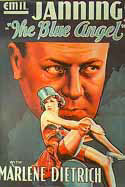 Although
Austrian-born director Josef von Sternberg's best works were in his
silent films (Underworld (1927), The Last Command (1928),
and The
Docks of New York (1929)), he acheived greatest notoriety during
the 30s. Exotic German actress Marlene Dietrich's stardom was launched
by von Sternberg's The Blue Angel (Germany, 1930) with her role
as the leggy Lola Lola, a sensual cabaret striptease dancer and
the singing of Falling in Love Again. It was Germany's first
all-talking picture. Although
Austrian-born director Josef von Sternberg's best works were in his
silent films (Underworld (1927), The Last Command (1928),
and The
Docks of New York (1929)), he acheived greatest notoriety during
the 30s. Exotic German actress Marlene Dietrich's stardom was launched
by von Sternberg's The Blue Angel (Germany, 1930) with her role
as the leggy Lola Lola, a sensual cabaret striptease dancer and
the singing of Falling in Love Again. It was Germany's first
all-talking picture.
Dietrich would soon go on to star in many other films - usually with
characters that were variations on Lola - jaded femme fatales.
Dietrich was 'discovered' and appeared in her first Hollywood feature
film, Morocco (1930), again as a nightclub singer with co-star
Gary Cooper as a French legionnaire. Dietrich was subsequently promoted
by Paramount Studios as a 'continental' German rival to MGM's imported
star Greta Garbo. A few years later, Dietrich collaborated further with
von Sternberg in Dishonored (1931), Shanghai
Express (1932), Blonde Venus (1932) (with Dietrich as a
demure wife who is transformed into a cabaret star), The Scarlet Empress
(1934) (with Dietrich as Russia's Catherine the Great), and in The
Devil is a Woman (1935) (as a money-hungry, seductive vamp). Dietrich
and von Sternberg made a total of seven films together. By 1946, von Sternberg
was the uncredited assistant to director King Vidor for Duel
in the Sun (1946).
The Sound Era's Coming-of-Age:
 Most of the early talkies were successful at the box-office, but many of them
were of poor quality - dialogue-dominated play adaptations, with stilted
acting (from inexperienced performers) and an unmoving camera or microphone.
Screenwriters were required to place more emphasis on characters in their
scripts, and title-card writers became unemployed. The first musicals
were only literal transcriptions of Broadway shows taken to the screen.
Nonetheless, a tremendous variety of films were produced with a wit, style,
skill, and elegance that has never been equalled - before or since. Most of the early talkies were successful at the box-office, but many of them
were of poor quality - dialogue-dominated play adaptations, with stilted
acting (from inexperienced performers) and an unmoving camera or microphone.
Screenwriters were required to place more emphasis on characters in their
scripts, and title-card writers became unemployed. The first musicals
were only literal transcriptions of Broadway shows taken to the screen.
Nonetheless, a tremendous variety of films were produced with a wit, style,
skill, and elegance that has never been equalled - before or since.
Rouben Mamoulian, a successful Broadway director, refused to keep the
cumbersome sound cameras pinned to the studio floor, and demonstrated
a graceful, rhythmic, fluid, choreographed flowing style in his films
- first with his directorial debut 1929 film Applause (1929) (and
later with Love Me Tonight (1932)), one of the first great American
musicals starring legendary Roaring 20s torch singer Helen Morgan in her
first film role. Applause also introduced a revolutionary sound
technique: a double-channel soundtrack with overlapping dialogue.
Mastery of techniques for the sound era were also demonstrated in the
works of director Ernst Lubitsch, who advanced the action of his films
with the integrated musical numbers. The first filmic musical was Lubitsch's first
talkie, the witty and bubbly The Love Parade (1929/30) with Jeanette
MacDonald (in her debut film) and Maurice Chevalier (in his second picture) - the recipient of six Academy Awards nominations (including Best Picture, Best Director, and Best Actor).
After directing three more musical comedies in the next three years, including Best Picture-nominated One Hour with You (1931/32) with the same leads, Lubitsch filmed his
last musical, The Merry Widow (1934) with equally naturalistic
musical expressions and the winner of the Best Art Direction Academy Award.
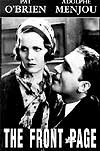 Also, in the first filming of the Ben Hecht-MacArthur play, Lewis Milestone's
The Front Page (1931), a mobile camera was combined with inventive,
rapid-fire dialogue and quick-editing. Other 1931 films in the emerging
'newspaper' genre included Mervyn LeRoy's social issues film about the
tabloid press entitled Five Star Final (1931) (with Edward G. Robinson
and Boris Karloff in a rare, non-monster role), Frank Capra's Platinum
Blonde (1931) (with Jean Harlow), and John Cromwell's Scandal Sheet
(1931).
Also, in the first filming of the Ben Hecht-MacArthur play, Lewis Milestone's
The Front Page (1931), a mobile camera was combined with inventive,
rapid-fire dialogue and quick-editing. Other 1931 films in the emerging
'newspaper' genre included Mervyn LeRoy's social issues film about the
tabloid press entitled Five Star Final (1931) (with Edward G. Robinson
and Boris Karloff in a rare, non-monster role), Frank Capra's Platinum
Blonde (1931) (with Jean Harlow), and John Cromwell's Scandal Sheet
(1931).
After 1932, the development of sound-mixing freed films from the limitations
of recording on sets and locations. Scripts from writers were becoming
more advanced with witty dialogue, realistic characters and plots. Hecht
adapted Noel Coward's work for Lubitsch's Design for Living (1933),
starring Gary Cooper, Fredric March and Miriam Hopkins, and Dudley Nichols
adapted Maxwell Anderson's play for director John Ford's screen version
Mary of Scotland (1936).
Two-Color and Three-Color (Full-Color) Technicolor Development:
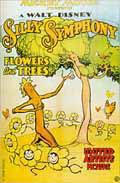 One of the first 'color' films was Thomas Edison's hand-tinted short Annabell's
Butterfly Dance. Two-color (red and green) feature films were the
first color films produced, including the first two-color feature film
The Toll of the Sea, and then better-known films such as Stage
Struck (1925) and The Black Pirate (1926). It would take the
development of a new three-color camera, in 1932, to usher in true full-color
Technicolor.
One of the first 'color' films was Thomas Edison's hand-tinted short Annabell's
Butterfly Dance. Two-color (red and green) feature films were the
first color films produced, including the first two-color feature film
The Toll of the Sea, and then better-known films such as Stage
Struck (1925) and The Black Pirate (1926). It would take the
development of a new three-color camera, in 1932, to usher in true full-color
Technicolor.
The first film (a short) in three-color Technicolor was Walt Disney's
animated talkie Flowers and Trees (1932) in the Silly Symphony
series. [However, others claim that the first-ever color cartoon
was Ted Eschbaugh's bizarre Goofy Goat Antics (1931).] In the next
year, Disney also released the colorful animation - The Three Little
Pigs (1933). Its optimistic hit theme song: "Who's Afraid of the Big Bad Wolf?"
(based upon the tune of Happy Birthday) became a Depression-era anthem. It was one of the earliest films displaying 'personality animation' - each of the three pigs had a distinctive personality.
In 1934, the first full-color, live-action short
was released - La Cucaracha (1934).
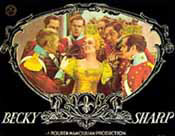 Hollywood's
first full-length feature film photographed entirely in three-strip
Technicolor was Rouben Mamoulian's Becky Sharp (1935) - an adaptation
of English novelist William Makepeace Thackeray's Napoleonic-era novel
Vanity Fair. The first musical in full-color Technicolor was Dancing
Pirate (1936). And the first outdoor drama filmed in full-color was
The Trail of the Lonesome Pine (1936). Hollywood's
first full-length feature film photographed entirely in three-strip
Technicolor was Rouben Mamoulian's Becky Sharp (1935) - an adaptation
of English novelist William Makepeace Thackeray's Napoleonic-era novel
Vanity Fair. The first musical in full-color Technicolor was Dancing
Pirate (1936). And the first outdoor drama filmed in full-color was
The Trail of the Lonesome Pine (1936).
In the late 30s, two beloved films, The Wizard
of Oz (1939) and Gone with the Wind (1939),
were expensively produced with Technicolor - what would the Wizard of
Oz (with ruby slippers and a yellow brick road) be without color? And
the trend would continue into the next decade in classic MGM musicals
such as Meet Me in St. Louis (1944) and
Easter Parade (1948). Special-effects processes were advanced by
the late 1930s, making it possible for many more films to be shot on sets
rather than on-location (e.g., The Hurricane (1937) and Captains
Courageous (1937).) In 1937, the Disney-produced Snow
White and the Seven Dwarfs (1937) was the first feature-length
animated film - a milestone. The colorful Grimm fairy tale was premiered
by Walt Disney Studios - becoming fast known for pioneering sophisticated
animation.
 Film History of the 1930s
Film History of the 1930s
Part 1, Part 2, Part 3, Part 4, Part 5, Part 6

 
|
